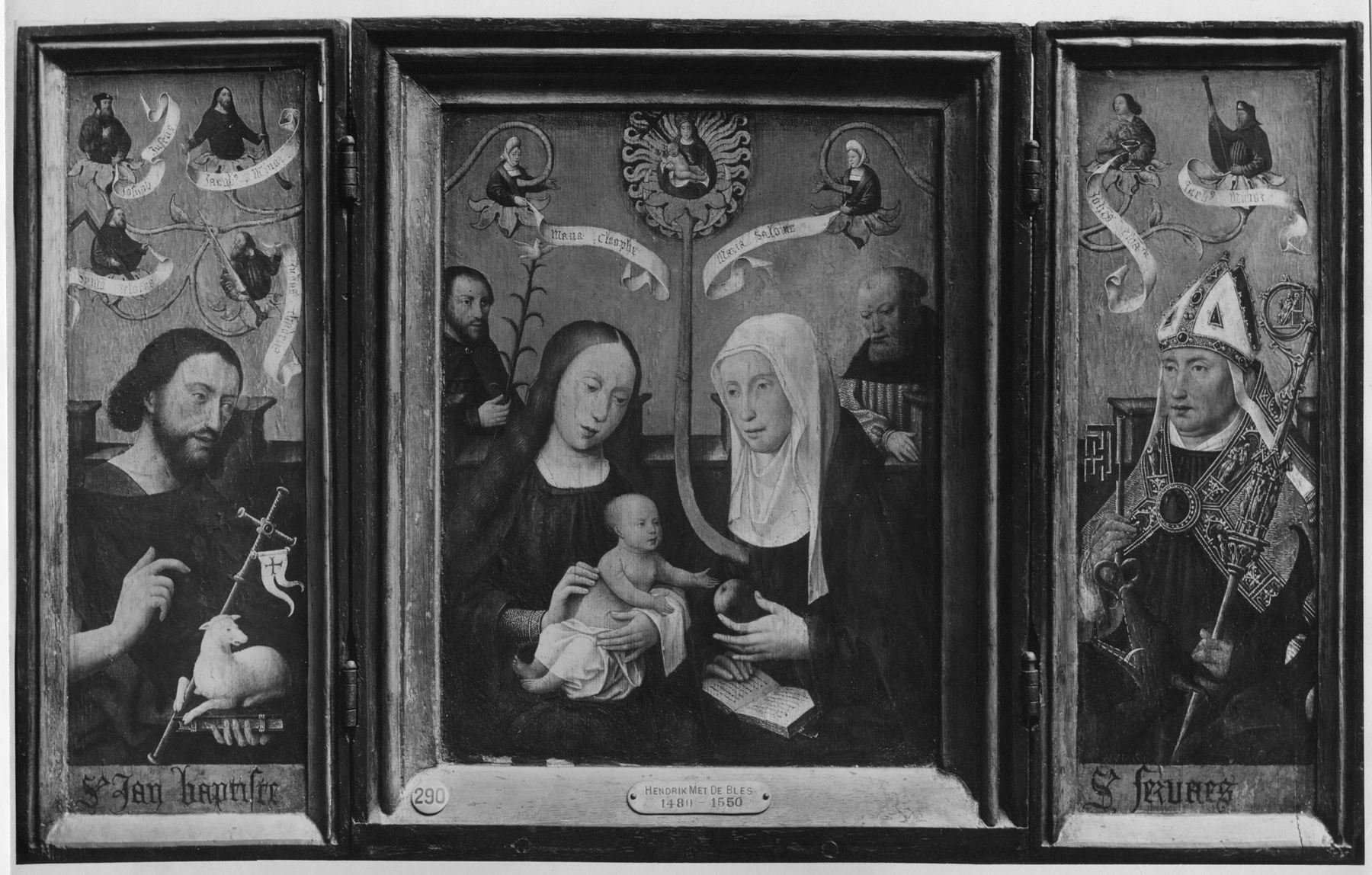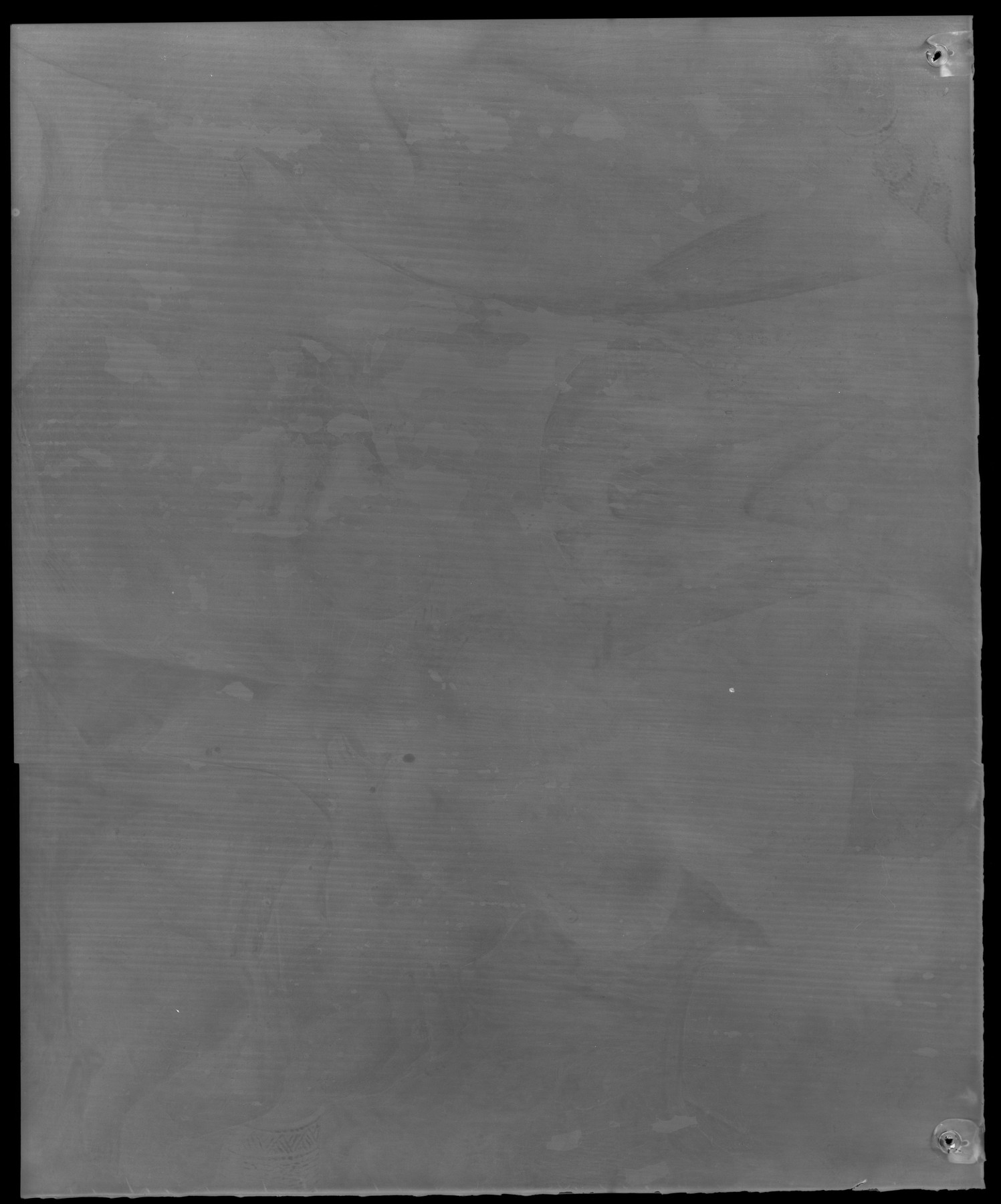Triptych: The Holy Kinship
(Renaissance Europe )
This triptych portrays the extended family, or kinship of Saint Anne, the mother of the Virgin Mary. Though the Virgin’s mother is not mentioned in the gospels as gathered in the New Testament, she and her husband Joachim were introduced briefly in the other early gospels of James and the Pseudo-Matthew. These gospels were drawn upon for the description of Anne’s extended family in Jacobus de Voragine’s (1228-1298) influential treatise on the saints, the Golden Legend (1293). The Holy Kinship became a popular subject during the Middle Ages, and by the fifteenth century, Saint Anne and her family were often represented as a family tree.
In the central panel, Anne is shown on the right, while the Virgin Mary is shown on the left with an infant Christ in her lap. At the top, a crowned Virgin and Christ are portrayed emerging from a flower that stems from the body of Saint Anne, referencing the belief that the Virgin was conceived immaculately through God without sin. The flower is also supported by a crescent moon, a device used to associate the Virgin with the woman of the Apocalypse described in the Book of Revelation. Saint Anne offers Christ an apple, a reference to the forbidden fruit Eve gave to Adam in the Garden of Eden, and a symbol of mankind’s sins that Christ will redeem. A parapet separates Saint Anne and the Virgin from Joachim (Saint Anne’s husband) and Joseph (the Virgin’s husband) on the back right and left. This parapet evokes the wall surrounding the “hortus conclusus” (enclosed garden) described in Song of Songs (4:12), and alludes to the purity of the two women and their offspring, as the Virgin Mary and Christ were both conceived through God, without the aid of Joachim or Joseph. Above, Saint Anne’s two other daughters—Mary Cleophas and Mary Salome—emanate from the flowers of the genealogical tree. At the very top of this central panel is the inscription “Ave regina coelorum/ Mater regis angelorum” (Hail queen of the heavens/ Mother of the king of angels) that was taken from a popular fifteenth-century song by the English composer Walter Frye (active ca. 1450-75). On the left wing of the triptych, a large figure of Saint John the Baptist holds a lamb and sits in front of the parapet, while above are the small figures of the sons of Mary Cleophas—Judas Thaddeus, James the Less, Simon, and Joseph the Just. On the right wing, Saint Servatius, wearing a bishop’s miter, stands behind a dragon, a symbol of his defeat of the devil. Above Servatius are the small figural sons of Mary Salome—John the Evangelist and James Major. This triptych was painted by the artist known today as the Master of the Magdalen Legend, who was active from 1483 until sometime after 1526 in the court of Brussels and at Mechlin. A characteristic of his work is the tendency towards disproportionately large hands, as seen here. Though the identity of the Master has not been proven, it has been suggested that he may have been Bernaert van der Stockt (d. 1538), Pieter van Coninxloo (1460- 1513), or Jan van Coninxloo (1489-1555). For other representations of the Holy Kinship, see 27.18, 27.294, 61.20, and W.182.47R.
Provenance
Provenance (from the French provenir, 'to come from/forth') is the chronology of the ownership, custody, or location of a historical object. Learn more about provenance at the Walters.
Don Marcello Massarenti Collection, Rome [date and mode of acquisition unknown]; Henry Walters, Baltimore, 1902, by purchase; Walters Art Museum, 1931, by bequest.
Conservation
| Date | Description | Narrative |
|---|---|---|
| 6/17/1941 | Treatment | cleaned; coated; filled; inpainted; reconstructed; surface cleaned; varnish removed or reduced; x-ray |
| 6/3/1987 | Examination | examined for condition |
| 8/3/1987 | Treatment | coated; filled; inpainted; surface cleaned; varnish removed or reduced |
| 12/1/1988 | Examination | examined for condition |
| 4/23/1990 | Examination | examined for condition |
| 5/1/2000 | Treatment | coated; surface cleaned |
Geographies
Belgium, Brussels (Place of Origin)
Measurements
Overall H: 17 3/8 x W: 28 1/16 in. (44.2 x 71.3 cm); Center panel H: 17 3/8 x W: 14 in. (44.2 x 35.6 cm); Wings H: 17 3/8 x W: 7 in. (44.2 x 17.8 cm)
Credit Line
Acquired by Henry Walters with the Massarenti Collection, 1902
Location in Museum
Not on view
Accession Number
In libraries, galleries, museums, and archives, an accession number is a unique identifier assigned to each object in the collection.
In libraries, galleries, museums, and archives, an accession number is a unique identifier assigned to each object in the collection.
37.290










